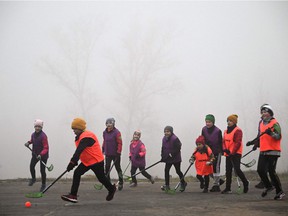Children spend less time being physically active, and more and more free play is being replaced by adult-led programs that don’t always prioritize keeping kids moving.

Postmedia can earn an affiliate commission for purchases made through our links on this page.
Article content
There has been a generational change in what children do after school. Gone are the days when they got off the bus, left their backpack at the back door, and played outside with friends until they were called for dinner. Today, most kids go straight from the classroom to the after school program and then picked up in time for dinner.
Commercial
This ad has not been uploaded yet, but your article continues below.
Article content
Not coincidentally, there has also been a generational shift in the number of minutes children spend in active play each day. Only 39 percent of youth ages 5 to 17 in Canada accumulate the recommended 60 minutes of moderate to vigorous physical activity per day. Given the sedentary nature of a typical school day, the extracurricular period is an excellent opportunity to play more in children’s lives. However, according to a report by ParticipACTION, the national nonprofit organization that promotes healthy living and physical fitness, children average only 14 minutes of moderate to vigorous exercise between 3 and 6 p.m. on weekdays.
These statistics are not unique to Canada. Children spend less time being physically active, and more and more free play is being replaced by adult-led programs that don’t always prioritize keeping kids moving. To learn more about what children do between the time they finish school and when they are picked up to go home, researchers from the University of Wollongong in Australia provided accelerometers to children in 89 after-school programs to track their movements over the course of a single session. They also had observers chronicle children’s activities by visiting after-school programs on two non-consecutive days between March 2018 and April 2019.
Commercial
This ad has not been uploaded yet, but your article continues below.
Article content
Observers coded the activity as free play (unstructured without staff intervention or direction), organized play (with rules and led by adults), or enrichment (non-physical activity such as reading, crafts, or homework). They included notes on staff instruction, children’s participation, the amount of time they spent on their feet in front of active play, and whether the activity promoted inclusion or elimination.
Only 26 percent of the 4,408 children included in the study were active for 30 minutes or more.
“We found that boys spent an average of 22 minutes in moderate to vigorous physical activity, and that boys accumulated significantly more moderate to vigorous physical activity than girls,” the researchers said.
Commercial
This ad has not been uploaded yet, but your article continues below.
Article content
Australia is not the only country looking at how much children move after school. An analysis of data from similar studies suggests that children in comparable after-school programs spend about 54.5 minutes per session in sedentary activities.
How do after-school programs lead to more active play?
Observers in the Australian study found that children were six times more likely to accumulate 30 minutes of active play when left alone and twice as likely when they participated in organized games led by staff.
“Given the autonomous nature of free play, it is likely that not all children choose to engage in active play during this time, therefore organized structured activities can be an important activity to incorporate within (after school) settings. ) to maximize participation; this could involve a broader range of children, especially girls, ”the researchers said.
Commercial
This ad has not been uploaded yet, but your article continues below.
Article content
Maximizing opportunities for children to be active should be a priority when designing extracurricular programs. Too often time spent explaining and organizing an activity means that children spend less time moving around. The same goes for activities that require taking turns or eliminating children who are “out.”
“Our results report that the odds of children engaging in 30 minutes of moderate to vigorous intensity physical activity were cut by almost half when organized play included elimination components in their activities,” the researchers said.
Given the increase in sedentary lifestyles, not only for children but also for their parents, it takes a planned and consistent effort to increase participation in active play, especially among children who are not confident in their movement skills. Adding more free play and adult-led activities designed to engage children and keep them active has the potential to increase the number of children who exercise for the recommended 60 minutes a day.
Commercial
This ad has not been uploaded yet, but your article continues below.
Article content
But more than adhering to a set of guidelines designed to improve the health of children who sit too much and move too little, encouraging children to play more active games allows them to explore their physical limitations, push boundaries, and gain confidence. on his athletic abilities. Best of all, an active after-school program allows kids to recharge their batteries after a school day that rewards sitting down.
Children are not meant to be sedentary, but they often lack permission or the opportunity to participate in high-energy, unstructured active play. An after school program that rewards children for being active, in any shape or form, is one that understands the importance of creating healthy habits. Active kids sleep better, eat better, and can focus better on their tasks – exactly what they need to get them started the next day on the right foot.
-
Fitness: How Aging Athletes Stay Active into Their 80s
-
Fitness: kids don’t exercise like adults
-
Fitness: a smartwatch with fall detection could save a solo athlete
Reference-montrealgazette.com


